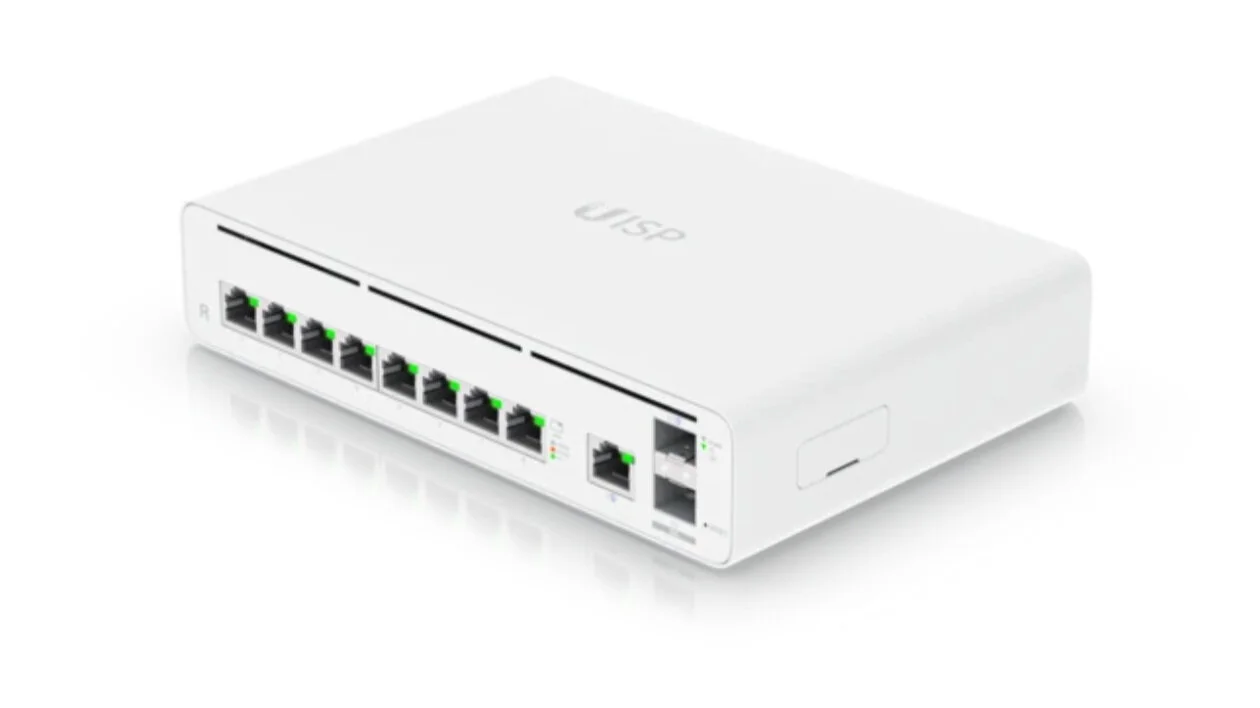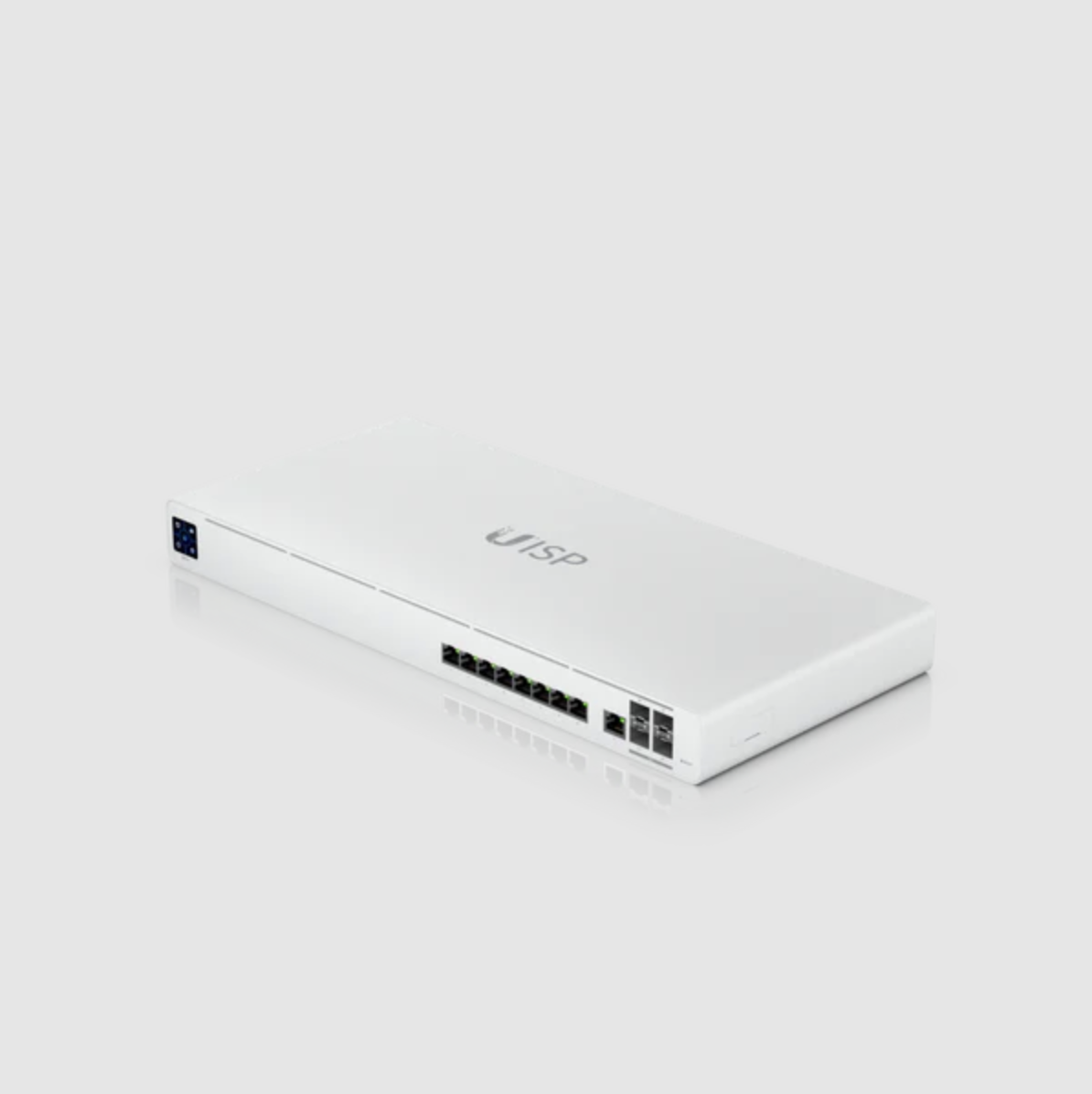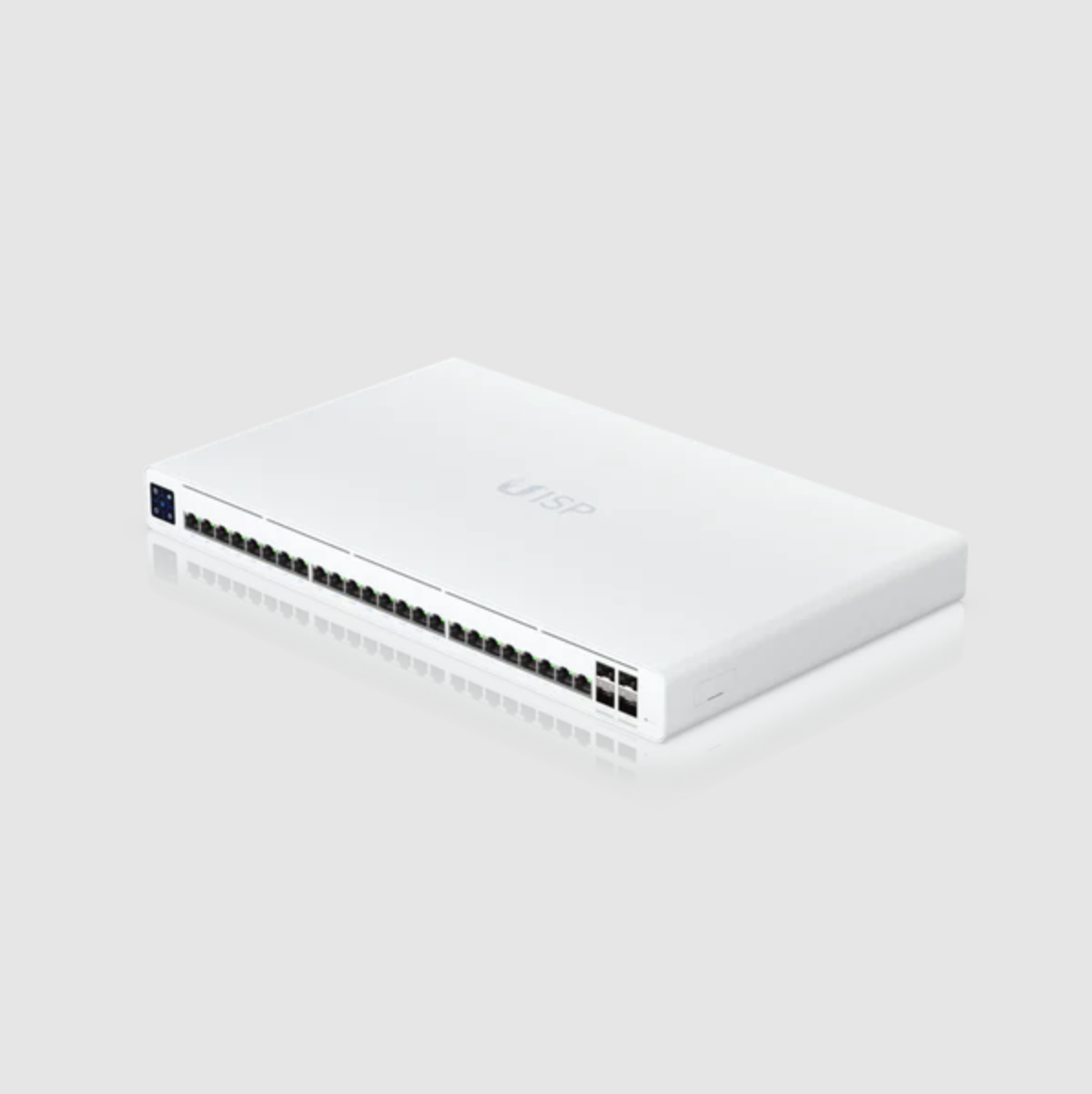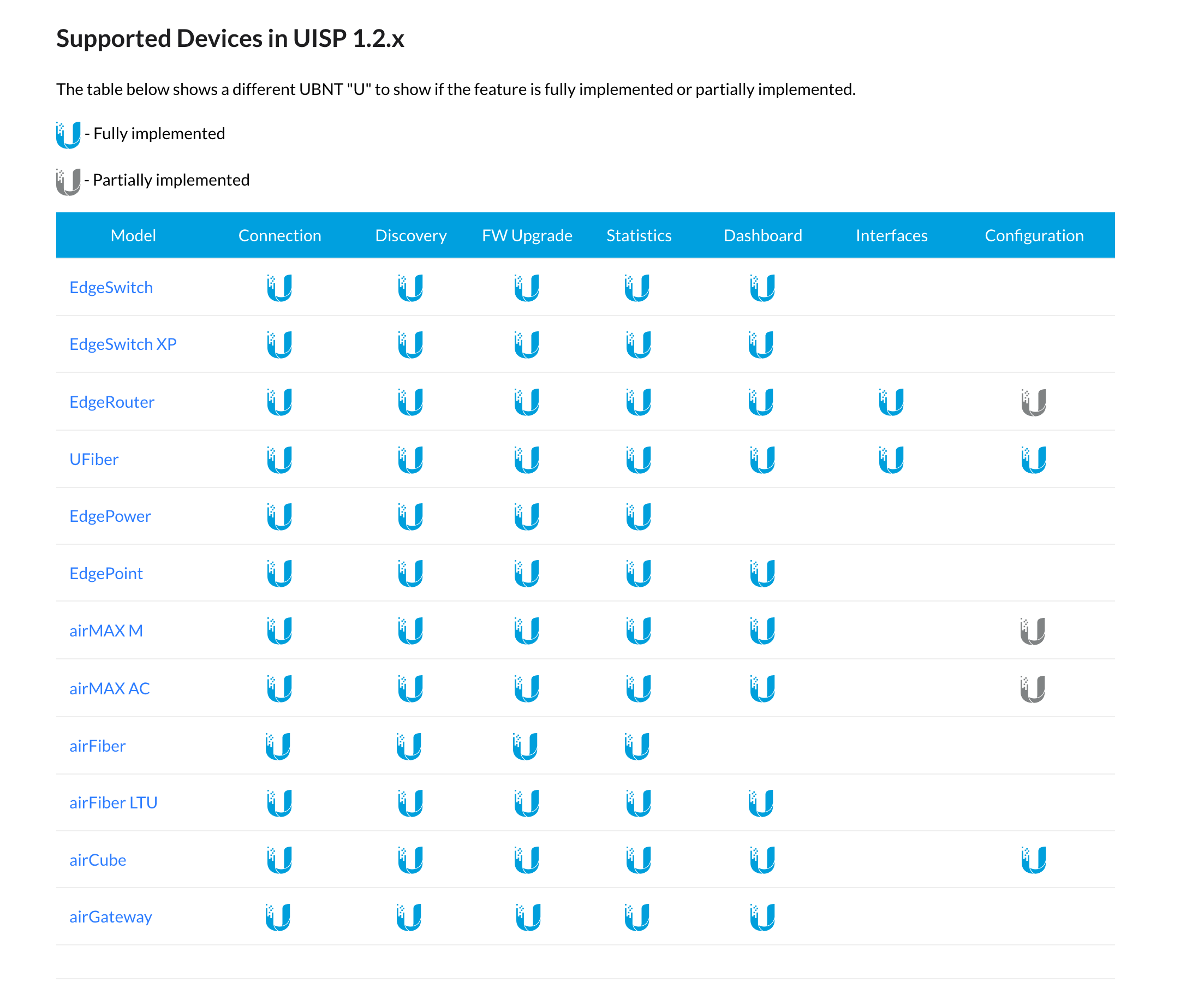Ubiquiti: UISP Is The New UNMS
Originally Posted: December 29th, 2020
Last Edited: September 12th, 2022
Ubiquiti: UISP Is The New UNMS
Back in November 2020, Ubiquiti announced it was changing the name of UNMS to UISP. In their announcement:
UISP in action.
We are excited to usher in a new era for our ISP management software: on November 16, we will begin renaming the UNMS platform and devices to UISP. This change, one of the name only, will clarify Ubiquiti’s current product offerings:
UISP - solution for internet service providers, including UNMS, airMAX, EdgeMAX, airFiber, UFiber, etc.
UniFi - end-to-end networking ecosystem for businesses and smart homes of all sizes
AmpliFi - WiFi and routing products for consumersThis change will take place over the coming weeks -- in the interim, the “UNMS” name may remain in certain places.
Ubiquiti also updated their website, emphasizing all the products and software that they make to support the operation of an Internet Service Provider. The tab on their website labeled "ISP" recently changed to use the domain of uisp.com. On that page they show off their AirFiber PtP Wireless Bridges, LTU and AirMAX PtMP radios, their new UISP Design Center, UISP, UCRM, UFiber optical terminals, Solar switches, and accessories. As someone who works for a WISP, these changes caught my attention.
UISP Software Changes
Beyond the name change and new marketing materials, there has been some development of the software itself. In late January 2021 Ubiquiti released UISP version 1.3.7, which was a big update with many changes. A lot of the new features focus on UCRM, which is their customer relationship management software inside UISP. UCRM supports customer accounts, invoicing, billing, payments, ticketing, scheduling, and other related tasks. Version 1.3.7 built out a lot of those features for UCRM, and it seems to be a big focus of UISP going forward. There were also a few smaller changes, like the start of a UI redesign, and a few under the hood changes and bug fixes. Version 1.3.7 also added support for the new UISP-branded routers and switches — more on those later.
The development of the 1.3.x train had a few issues, with versions 1.3.0 and 1.3.4 being locked, which is Ubiquiti's way of saying that release has critical issues and should not be installed. The comments on the 1.4.0-beta.2 aren't encouraging either, with some users saying they are having trouble with that version as well. UISP and UCRM are promising, but this kind of instability should be taken a sign that it’s a bit early to fully rely on it for all of your network monitoring and customer interactions.
If you’re familiar with Ubiquiti’s software development standards, this isn’t surprising. That’s the biggest knock I have against UISP and Ubiquiti in general — their software can be rough, and updates require careful investigation. You can never assume Ubuiqiti’s software and firmware are going to be stable and issue-free. Obviously, this isn’t a good quality for software that supports important network infrastructure. Ubiquiti’s hardware is cost-effective, but the software continues to let it down.
The Bad News About UISP Hardware
Ubiquiti states that their goal with the UISP devices is not to build feature-rich devices like the EdgeRouter or EdgeSwitch lines. They want to build devices which will auto-configure with help of the UISP controller software.
The UISP series doesn’t have a CLI or an individual web interface. They are designed to be fully managed from the UISP controller software or via Bluetooth in the mobile app. Changes from SSH aren't preserved across reboots or updates.
Just like the early days of the UDM-Pro, basic features like DHCP can be broken, and some features will be buggy, incomplete, or missing.
CPUs: ARM and MIPS
The UISP Router Pro uses an ARM CPU, similar to the one in the UDM-Pro, and doesn't have any hardware offloading capabilities.
The UISP Router Lite uses a MIPS CPU, like the CPU used in EdgeMAX devices like the EdgeRouter 10X.
I’m not sure why Ubiquiti is using two different CPU architectures, and they haven’t made any public statements about their reasoning.
Instead of improving EdgeMAX, Ubiquiti is choosing to build something new from the ground up. Just like with the Dream Machines, there will be features that were implemented or possible on the older equipment that aren’t present on the new equipment. Ubiquiti’s goal of auto-configuration and a minimum feature set are at odds with what people expect from the EdgeMAX line and their other ISP-focused products. Without the flexibility of a fully-featured CLI for configuration, we have to rely on the features they implement in UISP.
Part of this is necessary, and what it takes to move to a more modern platform. On the other hand it’s a self-own, where Ubiquiti’s equipment is losing features, losing flexibility, and best-case will result in a more restrictive “automatic” configuration which won’t fit every network. For the consumer and small-business focused UniFi line, this favoring of ease-of-use makes sense. I don’t think the same can be said of ISP networks, or those with serious networking needs.
Overall, proceed with caution. The UISP devices are not ready for production networks, which is why they are still in the early access store. The firmware and software aren’t finished, and not all features are present. Even when the UISP devices are released, Ubiquiti doesn’t claim that the UISP devices will be full-fledged replacements for EdgeRouters and EdgeSwitches. With all those warnings out of the way, let's look at the 3 products that are coming.
UISP Routers and Switches
Beyond the UISP software, there are some upcoming UISP hardware which can help shed light on what is next. There are 3 devices with UISP (previously UNMS) in the name. These UISP products aren’t a straightforward replacement for EdgeMAX, just like the Dream Machine didn’t directly replace the USG and USG-Pro on the UniFi side.
UISP Router
The UISP Router.
Gigabit PoE router for MicroPoP applications.
Ideal for wireless ISP (WISP) deployments, the UISP Router is a fanless PoE router featuring (8) GbE RJ45 ports and (1) 1G SFP port for an additional fiber uplink option. The UISP Router provides a cost-effective routing solution for WISPs looking to quickly and inexpensively deliver Gigabit wireless speeds to their customers. With its hefty 110W total PoE supply, the UISP Router delivers substantial power to every radio in your service network. The UISP Router is managed with the UISP application, a centralized platform where you can monitor and manage all of your UISP devices.
Features:
(8) GbE RJ45 ports with 27V passive PoE that support 2-pair and 4-pair modes
(1) 1G SFP port
110W PoE supply when powered with the included AC/DC adapter
Fanless, thermal cooling for silent operation
Wall-mountable (kit included)
Easy, Bluetooth-powered setup via the UISP Mobile app
UISP Console
The UISP Console.
UISP host console with an integrated switch and multi-gigabit Ethernet gateway.
The UISP Console is designed to support small to moderate UISP deployments with its built-in switch equipped with (8) GbE RJ45 LAN ports. The UISP Console also serves as a high-performance gateway with (1) 10G SFP+ LAN port and (2) WAN ports (10G SFP+ and GbE RJ45) that provide an ample connectivity range capable of supporting the most data-intensive deployments. Additionally, you can use the console's pre-installed UISP application to manage all of your UISP devices.
Features:
(2) 10G SFP+ ports
(9) GbE RJ45 ports
Powered by an external AC/DC adapter (included)
Compact, durable metal casing
1U rack or wall-mountable (kits included)
Easy, Bluetooth-powered setup via the UISP Mobile app
Pre-installed UISP application
UISP Switch
The UISP Switch.
Gigabit PoE switch for MicroPoP applications.
Ideal for wireless ISP (WISP) deployments, the UISP® Switch is a fanless, Layer 2 PoE switch with (8) GbE RJ45 ports and (1) 1G SFP port for an additional fiber uplink option. The UISP Switch is a cost-effective solution for WISPs looking to quickly and inexpensively deliver Gigabit wireless speeds to their customers. With its hefty 110W total PoE supply, the UISP Switch delivers substantial power to every radio in your service network. For larger deployments, pair it with the UISP Console to create a cohesive routing and switching hub. The UISP Switch is managed with the UISP application, a centralized platform where you can monitor and manage all of your UISP devices.
Features:
(8) GbE RJ45 ports with 27V passive PoE that support 2-pair and 4-pair modes
(1) 1G SFP port
110W PoE supply when powered with the included AC/DC adapter
Fanless, thermal cooling for silent operation
Wall-mountable (kit included)
Layer 2 switching features
Easy, Bluetooth-powered setup via the UISP Mobile app
Early Access Hardware
The UISP Router Pro.
The UISP Router Pro is in early access, as is the UISP Switch Pro. These specs are subject to change, as is any Early Access hardware. The Pro models are both larger, and meant to be mounted in a standard network rack. They offer more ports and more 10 Gbps connectivity than the basic models, and both feature the same 1.3” touchscreen for status that the UDM-SE and other UniFi equipment uses.
UISP Router Pro
Multi-WAN 10GbE router designed for ISP applications.
Features:
(9) GbE RJ45 ports
(4) 10G SFP+ ports
Integrated Layer 2/3 switch*
1.3" LCM color touchscreen
1U-sized, rack-mountable device
Simple, Bluetooth-powered setup via the UISP Mobile app
UISP Switch Pro
PoE switch with (24) GbE RJ45 ports, including (16) with 27V passive PoE output and (4) 10G SFP+ ports for high-speed fiber uplinks.
The UISP Switch Pro.
Ideal for WISP deployments, the UISP® Switch Pro (UISP S Pro) is a PoE switch with (24) GbE RJ45 ports, including (16) with 27V passive PoE output and (4) 10G SFP+ ports for high-speed fiber uplinks. The UISP S Pro has a robust 220W PoE supply and provides 2 or 4-pair mode functionality to ensure reliable support for your radio devices. Additionally, the rack-mountable UISP S Pro features a 1.3" LCM color touchscreen that concisely presents key device and network status information. The UISP S Pro can be set up in minutes and fully managed with the UISP application, a centralized platform where you can monitor and configure all of your UISP devices.
Features:
(24) GbE RJ45 ports, including (16) with 27V passive PoE output that support 2 and 4-pair modes
(4) 10G SFP+ ports
220W total PoE supply
Layer 3 switching features*
1.3" LCM color touchscreen
1U-sized, rack-mountable device (kit included)
Easy, Bluetooth-powered setup via the UISP Mobile app
Ubiquiti have these basic routing features ready:
Routing and VLAN configuration
OSPF (based on the FRR project)
Firewall/NAT
Switch configuration
DHCP server/client
ISP QoS for customers + suspend
Netflow
Speedtest
BGP and VPN support are coming “Later”
MPLS and PBR are not on their roadmap
What About EdgeMAX?
Ubiquiti seems to be abandoning their EdgeRouters and EdgeSwitches, which is a shame. With these three UISP devices in early access and no recent releases in the EdgeSwitch or EdgeRouter lines, the writing is on the wall. Just like how the UniFi Dream Machine and UniFi Dream Machine Pro were the de-facto replacement of the USG and USG-Pro, the UISP line appears to be the next generation of EdgeMAX. What remains to be seen if anything like the UXG line is announced, or if Ubiquiti backpedals on their goal of no command line interface or direct management of UISP devices.
Ubiquiti’s goal of auto-configuration and lack of CLI is baffling. Ubiquiti claims to support what ISP costumers need, but their actions and their new products don’t line up with their marketing material. Whoever is in charge of product decisions at Ubiquiti doesn’t seem to understand what their products are used for, and they aren’t earning any goodwill with their most faithful customers.
Under the hood, the guts of the USG and EdgeMAX products are old. They are both based on the open-source Vyatta networking platform, using MIPS processors. Rather than continue to develop those, Ubiquiti chose to start fresh with a custom Linux codebase, and a new line of products using ARM processors. For UniFi, that became the Dream Machine. For EdgeMAX, we are getting the UISP Router Pro. If I had to guess, the MIPS processor in the UISP Router Lite is Ubquiti testing out rolling out the same changes to older EdgeRouter devices. It’s anyone’s guess though, and Ubiquiti has always left us in the dark when it comes to the thoughts behind their decisions and the future of their products.
If you’ve followed the development of the Dream Machines and UniFi OS, you know what to expect here. With this transition comes software issues, missing features, and grumbling from the Ubiquiti faithful. Ubiquiti seems to see software-defined GUIs as the best solution, but their execution so far hasn’t backed that up. Until the software catches up with their vision, the lack of CLI and manual configuration hurts. Ubiquiti seems to be more interested in making pretty interfaces than making their products flexible, configurable, and stable.
For now and the foreseeable future, EdgeMAX are the most feature-complete devices, but I wouldn’t expect much development going forward. The slow development of the 2.x branch of EdgeMAX firmware is a prime example. We shouldn’t expect any new EdgeMAX hardware either, judging by the UISP devices being in development, their rebranding, and their limited official comments in their community forums.
My Assessment of UISP
Now that we've covered what UISP is and what's changing, I want to quickly cover what I think of it. As an overall package and from a distance, UISP seems appealing. Ubiquiti sells it as a centralized monitoring and customer relations platform, and in my experience it does some of that well. I’m just starting to dig into UCRM, which seems like a decent way to manage billing, customer relations, ticketing, and technician scheduling. I’ll have more to say about UCRM as I use it more.
On the network monitoring side, UISP definitely isn’t an all-things-to-all-people kind of software. As a basic way to monitor and receive alerts from EdgeMAX and AirMAX products, it’s passable. It’s not going to replace something like SolarWinds or other SNMP-based monitoring solutions. It’s not an IPAM solution. It’s not an asset tracking solution. In general, it’s an OK network monitoring overlay, but its disappointing that it lacks a lot of ISP-focused features.
UISP still doesn’t support configuration for many devices, and is missing support for some other features.
UISP is missing some basics:
Most existing device lines can’t be configured at all via UISP. (EdgeSwitch, EdgePoint, AirFiber, etc)
Configuration is only fully implemented on the UFiber and airCube lines.
For other devices, configuration is either not implemented, or basic tasks such as changing IP address or port settings aren’t supported.
There’s no way to schedule restarts, or do multiple device restarts at once.
The statistics and reporting are very basic and not customizable.
There’s no easy way to export data from UISP: Device lists, site lists, etc.
There’s no way to input diagrams, map fiber routes, fiber strand utilization, etc.
This list of open issues in the bug tracker for UISP, currently with 38 items.
UNMS vs. UISP: A Marketing Exercise
The name change from UNMS to UISP isn’t that noteworthy, but Ubiquiti’s plans for the future are. Ubiquiti sees UISP and web interfaces as their future, but there are still features that were part of AirControl that years later, UNMS/UISP still don’t support. The name change is a new coat of paint on a half-finished replacement for something that worked. A lot of what is in UISP is OK, but the list of what’s missing is long, and there hasn’t been enough movement on that front since UNMS was went 1.0 in 2019. Version 1.3.7 added a lot of features, but there’s still a lot more work that needs to be done.
On one hand, it's silly to complain about free software that comes with low-priced networking equipment. On the other hand, UISP isn't the feature-packed all-in-one network management and configuration solution that Ubiquiti claims it to be. What concerns me the most is Ubiquiti’s stated goals, and their history of releasing half-baked products and not delivering on promises. UISP still doesn’t fully support existing devices. Making new products that fully rely on UISP for configuration is going to require a lot of development work. Ubiquiti’s track record here isn’t great.
Overall, I’m not optimistic we’re going to end up with something that’s better than EdgeMAX. In the end, customers will be the ones paying for Ubiquiti’s odd design decisions and lack of flexibility. More likely, they’re going to move on to a different manufacturer that delivers the features they need.
Other Ubiquiti Guides and Reviews
- Unofficial Ubiquiti Guide
- Ubiquiti FAQ
- Ubiquiti's UniFi Ecosystem Explained
- How Wi-Fi Works, From Electricity to Information
- UniFi Wireless Access Point Buyer's Guide: 2021 Edition
- UniFi BeaconHD and Smart Power Plug Review
- UniFi Router Comparison: USG vs UDM vs UXG
- UniFi Dream Machine (UDM) Review
- UniFi Dream Machine Pro (UDM-Pro) Review
- UniFi Dream Machine vs. AmpliFi Alien
- How To SSH Into Your UniFi Dream Machine
- UDM Setup Guide: Discovery and Basic Settings
- UniFi Next-Gen Gateway (UXG-Pro) Preview
- Upcoming UniFi Switches Preview
- UniFi Switches Explained
- UniFi Switches Buyer's Guide
If you have more questions about Ubiquiti or anything in this post, leave a comment or contact me. I will do my best to point you in the right direction, or help in any way I can.





